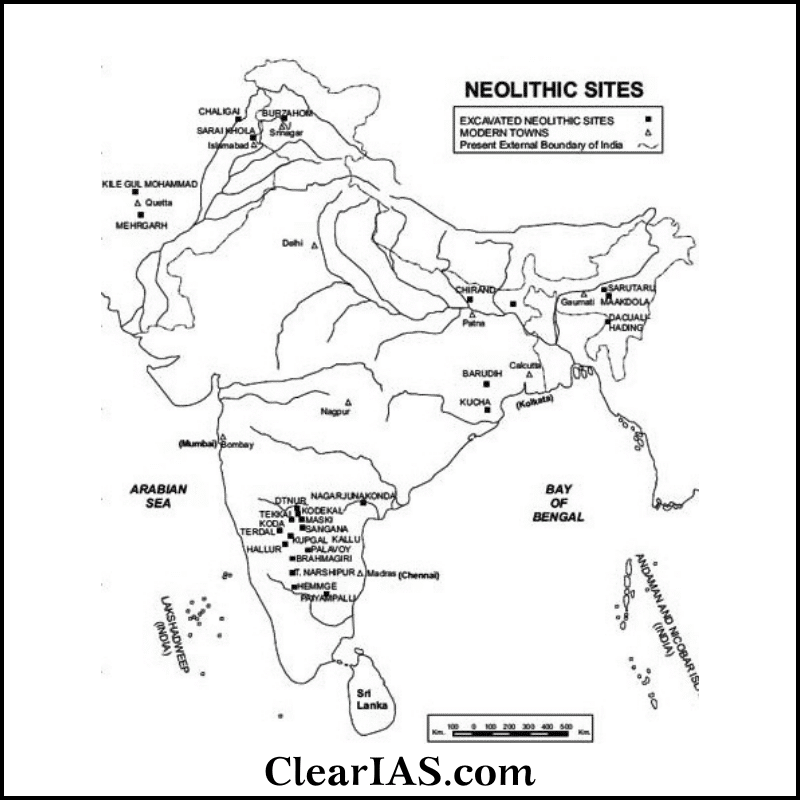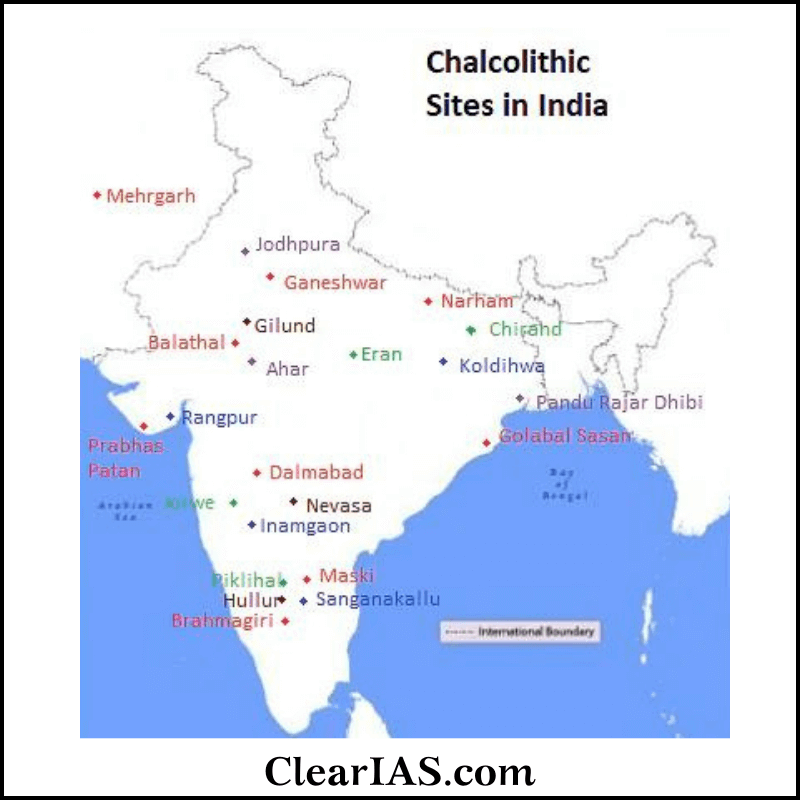 What do you mean by pre-historic India (era) and culture? Are there any sources that exist that help to find out the era? This article gives all the relevant information on Pre-historic India.
What do you mean by pre-historic India (era) and culture? Are there any sources that exist that help to find out the era? This article gives all the relevant information on Pre-historic India.
History (from the Greek word – Historia, meaning “inquiry”, knowledge acquired by investigation) is the study of the past.
Pre-historic India (era) refers to the time when there was no writing or development. It consists of five periods – Paleolithic, Mesolithic, Neolithic, Chalcolithic & Iron Age.
Sources of pre-historic India:
The sources which help in reconstructing history are:
- Literary sources – which include religious literature & secular literature.
- Non-literary sources.
Literary Sources
In literary sources, there are religious literature and secular literature exist.
Religious Literature
- Contain religious themes and these are known as Vedas (1500-500 BC).
- 4 Vedas.
Rig Veda- consists of prayers; praise of various gods.
Sama Veda- tune for chanting during the sacrifice.
Yajur Veda- rules observed during the sacrifice.
Atharva Veda- details of rituals.
- Upanishads- Philosophical discussion on Atma and Paramatma.
- 2 Epics- Ramayana and Mahabharata.
Mahabharata is attributed to sage Vyasa.
Originally consisted of 8800 verses and was called Jaya Gita or a song dealing with victory. Got expanded to 24,000 verses and contained the stories of the descendants of one of the earliest Vedic tribes called Bharata, that’s why it came to be known as Bharata.
A further expanded version of 1,00,000 verses was named Mahabharata.
Similarly, the Ramayana of Valmiki originally consisted of 6000 verses than 12,000 verses and was finally expanded to 24,000 verses.
- Sutras: a large number of ritual literature on moral values in a post-Vedic period called.
Shrautasutras- sacrifices, royal coronation.
Grihya Sutras- domestic rituals like birth, naming, marriage, funeral, etc.
- Buddhist religious text: The early Buddhist texts were written in the Pali language and are commonly known as Tripitaka (three baskets) – Sutta Pitaka, Vinaya Pitaka, and Abhidhamma Pitaka. These texts throw invaluable light on the social and economic conditions of that era. They also make references to political events in the age of the Buddha.
- Jaina’s religious text: The Jaina texts commonly called “angas”, were written in the Prakrit language, and contain philosophical concepts of the Jainas. They contain many texts which help to reconstruct the political history of eastern Uttar Pradesh and Bihar in the age of Mahavira. The Jaina texts refer repeatedly to trade and traders.
Secular Literature
- Doesn’t have religion as its theme.
- Dharmashastras/Law books – These lay down the duties for different varnas as well as for the kings and their officials. They prescribe the rules according to which property is to be held, sold and inherited. They also prescribe punishments for persons guilty of theft, murder, etc.
- Arthashastra – Arthashastra of Kautilya reflects the state of society and economy in the age of the Mauryas.
- Literary work of Kalidasa – The works of the great poet Kalidasa comprises kavyas and dramas, the most important being Abhijnanasakuntalam. Besides being creative compositions, they give an insight into the social and cultural life of northern and central India in the age of the Guptas.
- Rajatarangini – This is a famous book written by Kalhana and depicts the social and political life of 12th-century CE Kashmir.
- Charitas/Biographies – Charitas are the biographies written by court poets in admiration of their rulers such as Harshacharita written by Banabhatta in praise of King Harshavardhana.
- Sangam literature – This is the earliest south Indian literature, produced by poets who assembled together (Sangam), and provides valuable information about the social, economic and political life of the people living in deltaic Tamil Nadu. This Tamil literature contains literary gems such as ‘Silappadikaram’ and ‘Manimekalai’. Read more on Sangam Literature in the linked article.
Also, read sources of Ancient Literature
Non-Literary Sources
In non-literary sources, there are inscriptions, coins, archaeology and foreign accounts exist.
Inscriptions
- Writings engraved on hard surfaces such as stone, metal or terracotta. (epigraphy – study of inscriptions). They usually record the achievements, activities and ideas of those who got them inscribed. Those inscriptions which are composed by poets in praise of kings and patrons are known as prashastis.
- The earliest inscriptions were in Prakrit, a name for a language used by ordinary people. In later times, Tamil and Sanskrit were also used to write inscriptions.
- The Mauryan king Ashoka was the first person to issue inscriptions. Most of his inscriptions are in Prakrit language written in the Brahmi script though, some in the northwest, were written in Kharosthi. And Aramaic and Greek scripts were used for inscriptions in Afghanistan.
Coins
- The ancient Indian currency was not issued in the form of paper but as coins. were mostly minted in metals such as copper, silver, gold and lead. (Numismatics- study of coins)
- The earliest coins found in India contained only a few symbols, punch-marked coins made of silver & copper, but later coins mentioned the names of the kings, gods, dates, etc.
- Coins throw light on the economic history of different dynasties and also provide input on different parameters involved such as the script, art, and religion of that time.
Archaeology
- Archaeology is a science that enables us to systematically dig the successive layers of old mounds and to form an idea of the material life of the people of the past on the basis of remains found there.
- Archaeological studies help in the period before the invention of writing. In the proto-historic phase, Harappans knew how to write but historians have not been able to read it. The first script to be deciphered was Brahmi which was used in the Ashokan inscriptions and belongs to the third century BC.
- In south India, some people were buried along with their tools, weapons, pottery and other belongings under big and heavy stones. These graves are known as megaliths. Their dates are fixed according to radiocarbon dating.
Foreign Accounts
- Indigenous literature can be supplemented. To India came the Greek, Chinese and Roman visitors, either as travellers or religious converts, and left behind a rich account of our historical past.
- Some of the notables among them were:
- Greek Ambassador Megasthenes wrote “Indica” and provided valuable information about the Mauryan society and administration.
- “The Periplus of the Erythrean Sea” and “Ptolemy’s Geography” both written in Greek give valuable information about the ports and commodities of trade between India and the Roman empire.
- Fa-Hein Faxien (337 CE – 422 CE), a Buddhist traveller, left a vivid account of the age of the Guptas.
- Hsuan-Tsang, a Buddhist pilgrim, visited India and gave details of India under the reign of King Harshavardhana and the glory of the Nalanda University.
Pre-historic India: Periods
Pre-historic India (Ancient history) can be divided into different periods according to the tools used by people then.
- Palaeolithic Period (Old Stone Age): 500,000 BCE – 10,000 BCE
- Mesolithic Period (Late Stone Age): 10,000 BCE – 6000 BCE
- Neolithic Period (New Stone Age): 6000 BCE – 1000 BCE
- Chalcolithic Period (Stone Copper Age): 3000 BCE – 500 BCE
- Iron Age: 1500 BCE – 200 BCE
Stone Age
The primary source of knowledge for the stone age is archaeological investigations because it belongs to the pre-historic India (era), or the time before the invention of writing. The Pallavaram hand axe was discovered by archaeologist Robert Bruce Foote as the country of India’s first Palaeolithic tool.
On the basis of geological age, the type and technology of stone tools, and subsistence base, the Indian stone age is classified primarily into three types-
- Palaeolithic age (old stone age): Period – 500,000 – 10,000 BCE
- Mesolithic age (late stone age): Period – 10,000 – 6000 BCE
- Neolithic age (new stone age): Period – 6000 – 1000 BCE
Pre-historic India: Palaeolithic Age (Old Stone Age)

The word “Palaeolithic” is a combination of the Greek words “palaeo” for old and “lithic” for stone. Consequently, the phrase “Palaeolithic age” refers to the pre-historic India stone period.
The Pleistocene epoch, often known as the Ice Age, is a geological era during which the globe was covered in ice and the climate was so cold that neither human life nor plant life could thrive.
During this time, India’s old stone age or Palaeolithic culture emerged. The earliest species of men, however, could have lived in a tropical area where ice had melted.
Main characteristics of the Palaeolithic age –
- The Indian people are believed to have belonged to the ‘Negrito’ race, and lived in the open air, river valleys, caves and rock shelters.
- They were food gatherers, ate wild fruits and vegetables, and lived on hunting.
- There was no knowledge of houses, pottery, or agriculture. It was only in later stages they discovered fire.
- In the upper Palaeolithic age, there is evidence of art in the form of paintings.
- Humans used unpolished, rough stones like hand axes, choppers, blades, burins and scrapers.
Palaeolithic men are also called ‘Quartzite’ men in India as the stone tools were made of a hard rock called quartzite.
The old stone age or Palaeolithic age in India is divided into three phases according to the nature of the stone tools used by the people and also according to the nature of the change of climate.
- Lower Palaeolithic Age: up to 100,000 BC
- Middle Palaeolithic Age: 100,000 BC – 40,000 BC
- Upper Palaeolithic Age: 40,000 BC – 10,000 BC
Lower Palaeolithic Age (Early Palaeolithic Age)
- It covers the greater part of the Ice Age.
- Hunters and food gatherers; tools used were hand axes, choppers and cleavers. Tools were rough and heavy.
- One of the earliest lower Palaeolithic sites is Bori in Maharashtra.
- Limestone was also used to make tools.
- Major sites of the lower Palaeolithic age
- Soan valley (in present Pakistan)
- Sites in the Thar Desert
- Kashmir
- Mewar plains
- Saurashtra
- Gujarat
- Central India
- Deccan Plateau
- Chotanagpur plateau
- North of the Cauvery River
- Belan valley in UP
- There are habitation sites including caves and rock shelters.
- An important place is Bhimbetka in Madhya Pradesh.
Middle Palaeolithic age
- Tools used were flakes, blades, pointers, scrapers and borers.
- The tools were smaller, lighter and thinner.
- There was a decrease in the use of hand axes with respect to other tools.
- Important middle Palaeolithic age sites
- Belan valley in UP
- Luni valley (Rajasthan)
- Son and Narmada rivers
- Bhimbetka
- Tungabhadra river valleys
- Potwar Plateau (between Indus & Jhelum)
- Sanghao cave (near Peshawar, Pakistan)
Upper Palaeolithic age
- The upper Palaeolithic age coincided with the last phase of the ice age when the climate became comparatively warmer and less humid.
- The emergence of Homo sapiens.
- The period is marked by innovation in tools and technology. A lot of bone tools, including needles, harpoons, parallel-sided blades, fishing tools and burin tools.
- Major sites of the Upper Palaeolithic age
- Bhimbetka (South of Bhopal) – hand axes and cleavers, blades, scrapers and a few burins have been found here.
- Belan
- Son
- Chota Nagpur plateau (Bihar)
- Maharashtra
- Orissa and
- The Eastern Ghats in Andhra Pradesh
- Bone tools have been found only at the cave sites of Kurnool and Muchchatla Chintamani Gavi in Andhra Pradesh.
Pre-historic India: Mesolithic Period (Middle Stone Age)

Greek terms for “meso” and “lithic,” respectively, are the source of the phrase “mesolithic.” Meso means in the centre and lithic meaning stone in Greek. The Mesolithic period of prehistory is thus also referred to as the “Middle Stone Age.”
The Mesolithic and Neolithic periods are both considered to be Holocene in age. A rise in temperature and a warming of the environment during this time period caused the ice to melt and brought about changes in the flora and fauna.
Characteristic Features of the Mesolithic Era
- The people of this era believed in life after death and hence they buried the dead with food items and other goods.
- The first animal to be domesticated was the wild ancestor of the dog. Sheep and goats were the most common domesticated animals.
- The first human colonization of the Ganga Plains happened during this period.
- The Mesolithic men started to wear clothes made of animal skin.
- The people of this age lived on hunting, fishing and food gathering initially but later on they also domesticated animals and cultivated plants, thereby paving the way for agriculture.
- The Mesolithic people lived in semi-permanent settlements occupying caves and open grounds.
- The characteristic tools of this era were microliths– the miniature stone tools usually made of crypto-crystalline silica, chalcedony or chert, both of geometrical and non-geometrical shapes. They were not only used as tools but were also used to make composite tools, spearheads, arrowheads, and sickles after hafting them on wooden or bone handles. These microliths enabled Mesolithic man to hunt smaller animals and birds.
- The Mesolithic people were art lovers and initiated rock art. The subject matter of these paintings was mostly wild animals and hunting scenes, dancing and food collection were also depicted in such paintings. These rock paintings give an idea about the development of religious practices and also reflect the division of labour on the basis of gender.
Important Mesolithic Sites
- Bagor in Rajasthan is one of the biggest and best-documented Mesolithic sites in India. Bagor is on river Kothari where microliths along with animal bones and shells have been excavated.
- Adamgarh in Madhya Pradesh provides the earliest evidence for the domestication of animals.
- There are about 150 Mesolithic rock art sites across India, with a rich concentration in Central India such as Bhimbetka caves (Madhya Pradesh), Kharwar, Jaora and Kathotia (M.P), Sundargarh and Sambalpur (Odisha), Ezhuthu Guha (Kerala).
- Microliths have also been found in some valleys of rivers Tapi, Sabarmati, Narmada, and Mahi.
- Langhnaj in Gujarat and Biharanpur in West Bengal are also important Mesolithic sites. Bones of wild animals (rhinoceros, blackbuck, etc.) have been excavated from Langhnaj. Several human skeletons and a large number of microliths have been recovered from these places.
- Though pottery is absent at most Mesolithic sites, they have been found in Langhnaj (Gujarat) and in the Kaimur region of Mirzapur (U.P).
Pre-historic India: Neolithic Period (New Stone Age)

Neolithic is a name that comes from the Greek words “neo” for new and “lithic” for stone. As a result, the phrase “Neolithic Age” designates the “New Stone Age.” Since it brought about numerous significant changes in man’s social and economic existence, it is also known as the “Neolithic revolution.” In the Neolithic period, man transitioned from being a food gatherer to a food producer.
Characteristic Features of the Neolithic Age
- Agriculture – The people of the Neolithic age cultivated land and grew fruits and corn like ragi and horse gram (kulati). They also domesticated cattle, sheep and goats.
- Pottery – With the advent of agriculture, people were required to store their food grains as well as to cook, eat the product, etc. That’s why it is said that pottery appeared in this phase on a large scale. The pottery of this period was classified under grey ware, black-burnished ware, and mat-impressed ware. In the initial stages of the Neolithic age, handmade pottery was made but later on, foot wheels were used to make pots.
- Tools and Weapons– The people used microlithic blades in addition to tools made of polished stones. The use of celts was especially important for ground and polished hand axes. They also used tools and weapons made of bones – such as needles, scrapers, borers, arrowheads, etc. The use of new polished tools made it easier for humans to cultivate, hunt and perform other activities in a better manner.
- Housing and Settled Life– The people of the Neolithic age lived in rectangular or circular houses which were made of mud and reeds. Neolithic men also knew how to make boats and could spin cotton, wool and weave cloth. The people of the Neolithic age led a more settled life and paved the way for the beginning of civilization.
The neolithic people did not live far away from the hilly areas. They inhabited mainly the hilly river valleys, rock shelters and the slopes of the hills since they were entirely dependent on weapons and tools made of stone.
Important Neolithic Sites
- Belan Valley (which is located on the northern spurs of the Vindhyas and middle part of Narmada valley) – All three phases i.e., palaeolithic, mesolithic and neolithic ages are found in the sequence.
- Burzahom (Kashmir)– The domestic dogs were buried along with their masters in their graves; people lived in pits and used tools made of polished stones as well as bones.
- Gufkral (Kashmir) – This neolithic site is famous for pit dwellings, stone tools and graveyards in houses.
- Koldihwa and Mahagara (lying south of Allahabad) –This site provides evidence of circular huts along with crude handmade pottery. There is also evidence of rice, which is the oldest evidence of rice, not only in India but anywhere in the world.
- Mehrgarh (Balochistan, Pakistan) –The earliest Neolithic site, where people lived in houses built of sun-dried bricks and cultivated crops like cotton and wheat.
- Chirand (Bihar)– The neolithic men used tools and weapons made of bones.
- Piklihal, Brahmagiri, Maski, Takkalakota, Hallur (Karnataka) –The people were cattle herders. They domesticated sheep and goats. Ash mounds have been found.
Pre-historic India: Chalcolithic Age (Stone Copper Age)

Stone and metal tools began to be used together for the first time during the Chalcolithic Age. Copper was the first metal utilised. The Chalcolithic period was generally considered to be the pre-Harappan period, but it actually began in many areas of the country after the bronze Harappan culture.
Characteristics of the Chalcolithic Age
- Art and Craft– The chalcolithic people were expert coppersmiths. They knew the art of copper smelting and were good stone workers as well. They knew spinning and weaving and were well acquainted with the art of manufacturing cloth. However, they did not know the art of writing.
- Worship– Small clay images of earth goddesses have been found in the chalcolithic sites. It is thus possible to say that they venerated the Mother Goddess. In Malwa and Rajasthan, stylised bull terracottas show that the bull served as a religious cult.
- Pottery– The people of the stone-copper phase used different types of pottery, one of which is called black and red pottery and seems to have been widely prevalent in that era. The ochre-coloured pottery was also popular. The potter’s wheel was used and painting with white linear designs was also done.
- Rural settlements – The people living in the stone age were characterised by rural settlements and were not acquainted with burnt bricks. They lived in thatched houses made of mud bricks. This age also marked the beginning of social inequalities, as chiefs lived in rectangular houses while the commoners lived in round huts. Their villages consisted of more than 35 houses of different sizes, circular or rectangular in shape. The chalcolithic economy is considered a village economy.
- Agriculture & cattle rearing– The people living in the stone-copper age domesticated animals and cultivated food grains. They domesticated cows, sheep, goats, pig and buffaloes and hunted deer. It is not clear whether they were acquainted with the horse or not. People ate beef but did not take pork on any considerable scale. The people of the Chalcolithic phase produced wheat and rice, they also cultivated bajra. They also produced several pulses such as lentils (Masur), black gram, green gram, and grass peas. Cotton was produced in the black cotton soil of the Deccan and ragi, bajra and several millets were cultivated in the lower Deccan. The people belonging to the stone-copper phase in the eastern regions lived mainly on fish and rice, which is still a popular diet in that part of the country.
- Infant mortality – Infant mortality was high among the Chalcolithic people, as is evident from the burial of a large number of children in West Maharashtra. In spite of being a food-producing economy, the rate of infant mortality was very high. We can say that the Chalcolithic social and economic pattern did not promote longevity.
- Jewellery – The Chalcolithic people were fond of ornaments and decoration. The women wore ornaments of shell and bone and carried finely worked combs in their hair. They manufactured beads of semi-precious stones such as carnelian, steatite, and quartz crystal.
Important Chalcolithic Sites
- Malwa (Madhya Pradesh) – The settlements of Malwa culture are mostly located on the Narmada and its tributaries. It provides evidence of the richest chalcolithic ceramics, and also spindle whorls.
- Kayatha (Madya Pradesh) –The settlement of Kayatha culture was mostly located on the Chambal River and its tributaries. Houses had mud-plastered floors, pre-Harappan elements in pottery along with copper objects with sharp cutting edges were found.
- Ahar (Banas valley, South Eastern Rajasthan) – The people of this region practised smelting and metallurgy, and supplied copper tools to other contemporary communities. Rice was cultivated here.
- Gilund (Banas valley, Rajasthan) – Stone blade industry was discovered here.
- Daimabad (Ahmednagar, Maharashtra) – The largest Jorwe culture site in Godavari valley. It is famous for the recovery of bronze goods such as bronze rhinoceros, elephants, two-wheeled chariots with a rider and buffalo.
- Songaon, Inamgaon and Nasik (Maharashtra) – Large mud houses with ovens and circular pit houses have been discovered here.
- Navdatoli (on Narmada) – It was one of the largest chalcolithic settlements in the country. It was spread over 10 hectares and cultivated almost all food grains.
- Nevasa (Jorwe, Maharashtra) and Eran (Madhya Pradesh) – These sites are known for their non-Harappan culture.
- Chirand, Senuar, Sonpur (Bihar), Mahishdal (West Bengal) –These are the prominent chalcolithic sites in these states.
Also, to read the evolution of paintings from the pre-historic Indian period to the present age click here.
Since his appearance in the Pre-historic Indian period, humans have passed through many stages of cultural growth.
Archaeological sources show his existence and subsistence pattern at various sites in different parts of the subcontinent.
He was a hunter-gatherer in the Palaeolithic and Mesolithic periods. By the Neolithic period, he learnt cultivation of crops and domestication of animals
Article Written by Remya





There were no written sources in prehistoric times but you wrote about literary source. Why ?